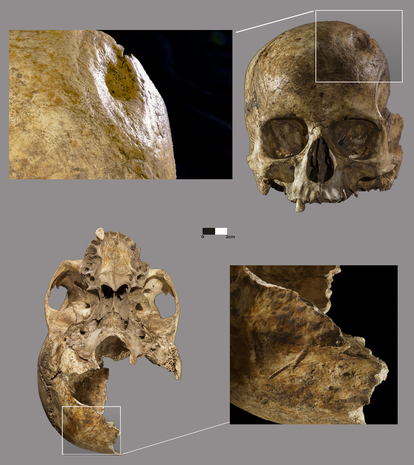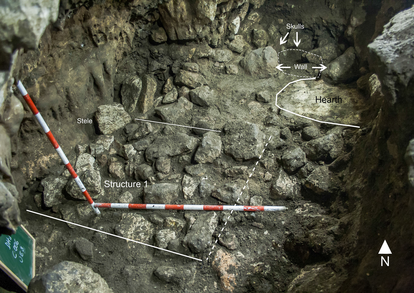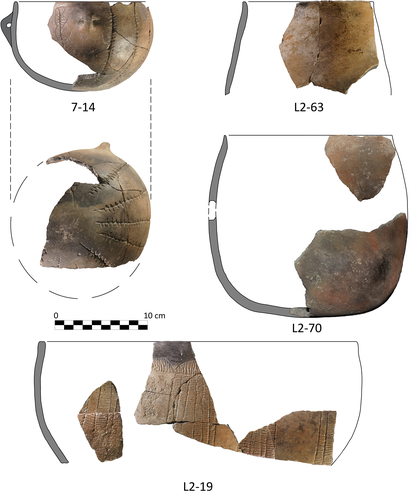Dig in southern Spain reveals decapitation, trepanation and other extraordinary burial rituals
A five-year investigation into a Neolithic settlement in Cádiz has revealed ceremonial practices took place there 1,000 years before they became widespread
/cloudfront-eu-central-1.images.arcpublishing.com/prisa/DPI7TKRWUFCP3DSJSFTSEWHAZ4.tif)
The woman was trephined while still alive and then decapitated. Her skull was deposited next to that of a man 25 years older than her and, possibly, of a high social standing. A lamb or goat was slaughtered as well and painstakingly decorated ceramic vases laid alongside them. The scene took place between 4,800 BC and 4,500 BC in the Dehesilla caves in the mountains of Cádiz in southern Spain at a time when burials were commonly individual or multiple and performed outside or in simple cavities in the rock. The mix of ritual elements, including stone tools, plant residues and stones arranged as a type of altar make Dehesilla a unique place for studying the culture of the mid-Neolithic age. Excavations at the site, led by University of Seville archeologist Daniel García Rivero, will continue when the coronavirus pandemic permits. “The cave has been social distancing,” jokes Rivera, who is putting the finishing touches on a batch of new findings.

The community that lived at Dehesilla was ahead of its time. A paper on the most important discoveries to date, published in the scientific journal Plos One, notes that “the monumental nature of some of the earth and stone funerary structures is a distinctive trait of the Late Neolithic and the appearance of megalithic elements is generally associated with this period,” which is dated to between the third and fourth millenniums BC. However, centuries beforehand in the mountains around Cádiz, a group of men were already performing extraordinary burial rituals as confirmed by the discoveries at Dehesilla.
Determining the age and gender of the Dehesilla couple has not been easy, due to a lack of teeth and pelvic bones, but detailed examinations of the morphology of the remains have allowed researchers to conclude they belong to a man and a woman. Estimates of their ages vary between the different models employed but based on dental decay on a canine and a molar and other dating methods, the woman is believed to be between 24 and 40 years old and the man between 30 and 50.

Their skulls were deposited within 20 centimeters of each other with both facing to the west. García Rivero – who has been researching the site for five years – explains that the remains of the woman display a “fissure from an unfinished trephination, but one that is very deep and reached to within a few millimeters of the brain.” Initially, it was thought that this could have been the cause of her death but further investigation revealed signs of healing in the bone, meaning that the procedure, possibly with surgical intent, was performed before she died. Both sets of remains show signs of “physiological stress,” which the researchers have attributed to anemia. The woman’s remains show three indications compatible with a benign tumor.
Decapitation
Based on the cut marks on the occipital of the woman’s skull, the researchers believe that decapitation occurred shortly before her death. “Although it cannot be stated categorically, it is quite possible that death was chronologically close to the time of deposition of the skull (if not at the time of death itself, before complete tissue decomposition).” The male skull showed no evidence of similar cuts. “The stratigraphic information guarantees the contemporaneous deposition of both skulls and several other elements of the context. Although the simultaneous natural death of both individuals (or the secondary burial of one of them) cannot be ruled out, the natural death [of] one and the ritual sacrifice of the other, or the sacrifice of both, may be equally likely,” the report concludes.

Among these “elements” was the striking discovery of the headless remains of an infant sheep or goat. “It is possible that it was also decapitated,” says García Rivero. This find, the paper states, lends weight to the theory of “new anthropological scenarios, perhaps sacrifices (human and animal) related to propitiatory activities, divine prayers and/or commemorative festivities (cosmogonic, seasonal rites…).”
These festivities, the study suggests, may have been linked to the arrival of spring due to the youth of the discovered animal. Its ritualistic nature is supported by the stone platform situated in a natural alcove in the wall of the cave, which the researchers believe could have been used as a form of altar. What’s more, researchers also discovered ceramic vases featuring a ramiform design common in the schematic rock art of the era, but with a very unique design. Along with these finds, objects and tools made of flint, carbonized seeds and branches and carved bones were also uncovered. “It’s a unique combination,” notes García Rivero.
The archeologist explains that the presence of skulls at similar sites can usually be attributed to the remains of enemies, placed there as trophies of war, or if the location was considered to possess magical properties. But in the case of Locus 2, as the Dehesilla site has been named, the hypothesis is that this was a place of ritual significance that was maintained for a long time and held special significance. “The sacrifice discovered in Cádiz doesn’t appear to have taken place as the result of a punishment based on the time invested in the ritual, in the putting together of the stone structures and given the characteristics of the objects uncovered,” explains García Rivero. “Everything points to the two skulls belonging to people who had religious or social relevance in the population. The age of the man could indicate a prestigious elder in the community.”

The exceptional preservation of the remains – which have survived the passing of millennia and the actions of water, animals and humans – the accumulation of objects and the age of the site make Dehesilla a unique location. The presence of human skulls has been documented at other settlements but these are much more recent. Maria Giovanna Belcastro, an archeologist at the University of Bologna, has unraveled the mystery of one belonging to a woman who died between the ages of 24 and 35 sometime between 3,630 BC and 3,380 BC. In an article also published in Plos One, Belcastro says that the find, made in 2015 in an indentation in the wall 12 meters off the ground in the Marcel Loubens cave in France, showed signs of mutilation that took place after a funerary ritual. The location of the skull had perplexed researchers but Belcastro believes that it was probably pushed to its eventual resting place by the movement of water and earth in the cave. Another study by a team at the Autonomous University of Barcelona, published in the Journal of Archaeological Science: Reports, notes the presence of sacrificial dogs in ceremonies dated to between 4,200 BC and 3,600 BC.
But the discovery of a combination of ritual elements on the Iberian peninsula, where they are most documented, as well as the date of the find, make the Dehesilla cave a unique site that could rewrite the pages of prehistory.
English version by Rob Train.

/cloudfront-eu-central-1.images.arcpublishing.com/prisa/UI6I2AGOHBE6TK3PAW2RIXQCP4.jpg)
/cloudfront-eu-central-1.images.arcpublishing.com/prisa/M24MGQQVSRE4XGI7PIZ5NLTYFQ.jpeg)










































